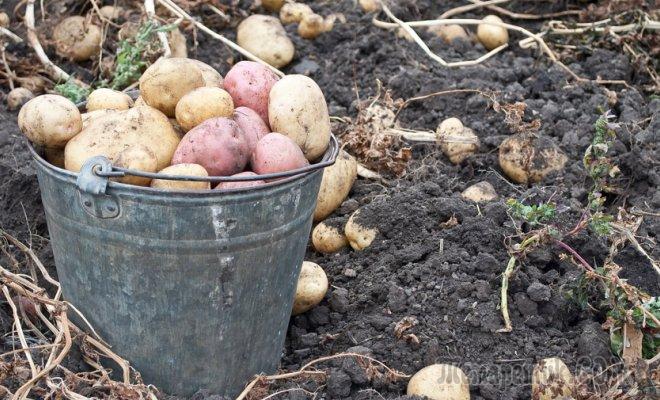 I would like to try the fruits of early potatoes already in the summer season, because the crop from last year managed to lose all its taste and appetizing appearance. A properly selected variety of potatoes and compliance with the technical rules for planting will help to collect young potatoes and enjoy the fruits in June.
I would like to try the fruits of early potatoes already in the summer season, because the crop from last year managed to lose all its taste and appetizing appearance. A properly selected variety of potatoes and compliance with the technical rules for planting will help to collect young potatoes and enjoy the fruits in June.
The main period of harvesting potatoes falls at the beginning of the fall season. But to determine the exact time when you need to harvest potatoes is not within the power of experienced gardeners, since there are a number of circumstances that can affect the establishment of deadlines for starting work. Depending on the climatic conditions, the specific variety of potato and the period of its planting, the time of flowering and ripening of tubers may vary. So, the potato's readiness for harvest is determined only after a careful examination of the appearance of the root crop and assessment of the soil condition. Agronomic practice on the territory of our strip, conducted in the suburbs of Moscow, shows that the appropriate time for harvesting potatoes can be calculated based on several factors.
Content
- 1 When does a potato finish blooming? Signs of the end of flowering potatoes
- 2 When can I dig potatoes? We determine the timing of digging young potatoes after flowering
- 3 How to dig potatoes? Technical Aspects of Digging Potatoes
- 4 What potato harvesting methods are there?
- 5 How to store new potatoes after digging it up? Tips & Tricks
When does a potato finish blooming? Signs of the end of flowering potatoes
It is possible to determine the final stage when the potato finishes blooming and the early harvest is ready to start digging it out according to the following distinguishing features:
- Potato bushes have already bloomed.
- Berries began to grow on the potato stalks.
- The growth of the tops has stopped.
- Potato tubers are much smaller in size than mature potatoes.
- The depth of the tubers under the yellowed leaves reaches 20 cm.
After flowering of potatoes, you can set the time for digging it.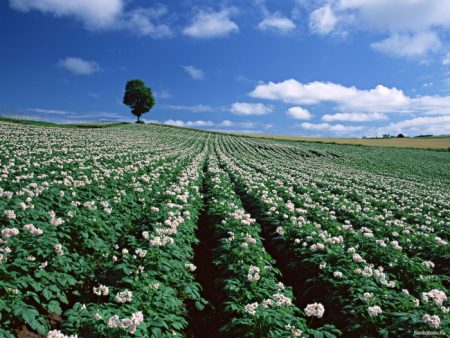
When can I dig potatoes? Determine the timing of digging young potatoes after flowering
There are several “external” factors by which it can be determined that a young potato is ready to start digging. Each experienced gardener knows that, first of all, it is necessary to pay attention to the following indicators:
- Tubers appearance
After the young potato has passed the budding stage - it has managed to bloom, after some time tubers begin to appear. Once they reach a size of 5 cm, you can already think about digging up a culture.
It is important, in time to have time to dig up young potatoes, not missing the moment when the root crop will already go to the stage of ordinary potatoes.
It is interesting that the taste of potatoes can depend on the specific methods used to care for the crop - the choice of type of fertilizing and mineral fertilizers, pest control products, irrigation regime and intensity, water purity, as well as soil temperature conditions. It is also important to dig potato beds in time, observing the changes in the state of plants and soil.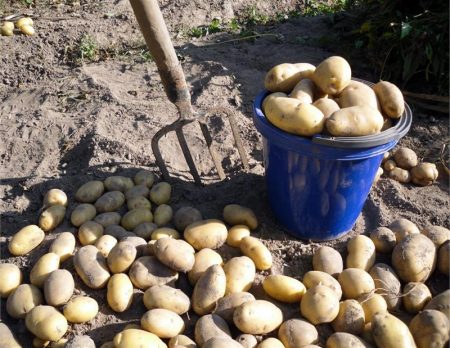
When do you need to dig up young potatoes?
During the flowering period of potatoes, it is necessary to make an approximate estimate of the time it takes to wait to start digging the beds.Usually the time period from the moment when the potato has bloomed and before its digging is 14-20 days. In terms of the appearance of undermined potatoes, one can get ahead of the degree of yield: if the potatoes have grown to a decent size, then the result will be rich.
Since the tubers will continue to grow for about another 30 days, it is important not to cause mechanical damage to the planting during the digging of potatoes. So, digging potatoes is recommended on the sides of the ridge.
Horticultural practice is impossible without making mistakes - excessive haste or, on the contrary, delaying potatoes from any of the necessary “care” procedures can add a specific aftertaste to the potato after its preparation or change the consistency of the dish until watery. But only by experience, by trial and oversight, can a good result be achieved in the cultivation and digging of young potatoes.
- Potato tuber conditions
The readiness of young potatoes for collection can be determined by digging one potato bush from the garden. The size and number of tubers will indicate the degree to which the root crop is ready for harvest.
Gardeners are advised to approach the choice of the first bush for digging by the method of assessing the condition of the soil - if the upper ground layer of the ridge crest is cracked, this indicates the tuber is ready for harvest. This occurs due to the "spreading" of the potato in the process of its growth wrapped on top of the soil layer, forming cracks.
The quality of the density and thickness of the potato peel can also indicate the readiness of the root for digging. In summer, the potato skin is less hard. But from the variety variety, the peel can “manifest” itself in different ways - peel off during friction or maintain its density. Therefore, based on this indicator, only a few potato bushes can be estimated.
- Plant conditions in its aerial parts
Yellowed and dried leaves are a characteristic indicator of the readiness of a young potato for digging it out. However, it is worth considering the factor that the color changes of the stems or their drying out can occur for a number of other reasons, for example, with an excessive nitrogen content in the soil.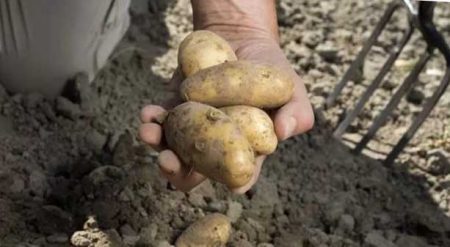
It is also not recommended to rely on this symptom as the main one, since potato beds are often planted from different varieties, which means that root crops will bloom and ripen at different times.
So, experienced gardeners are advised not to wait until the tops are completely dry - the desired percentage of its wilting is one seventh of the entire planting. If you “tighten” it too much by digging up tubers, you can get dull and soft potatoes that “waited” for their harvest time in conditions of lack of moisture.
Digging up new potatoes should be done gradually, removing the tubers in several batches.
How to dig potatoes? Technical Aspects of Digging Potatoes
To minimize damage to potato tubers when they are being dug up, it is necessary to remove the weeds from the beds when mowing leaves. This approach will make the rows more “clear”, and the rest of the vegetation will no longer interfere with the process of collecting potatoes.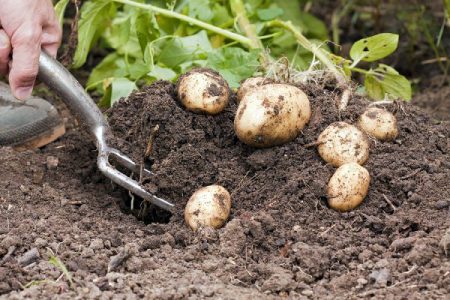
The tops should be cut off, leaving an interval of 10 cm from the stem, waiting one day or a couple of days before starting work with a shovel. Such formations in the form of “stumps” will help to more accurately navigate the position of the bush, and residual substances during this time will additionally “nourish” potato tubers. Mowing the aerial parts of the plant also reduces the risks of possible infection of potato tubers.
But the need for preliminary mowing of vegetation is not a mandatory measure if the territory of the garden plot is not too large. If the zone of planting potatoes reaches several hundred, then to remove weeds and dig up tubers it is better to use not ordinary tools - a shovel and pitchfork, but to attract a walk-behind tractor for such work.
What potato harvesting methods are there?
Potatoes are harvested using potato harvesters or potato diggers according to several possible technological schemes: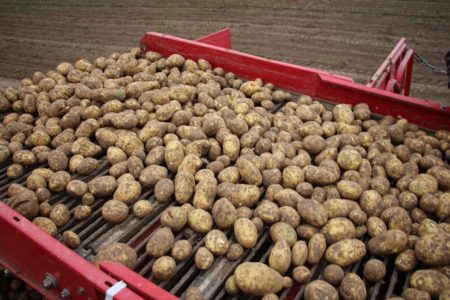
- Using direct combining technology
Digging up tubers occurs by separating them from the soil and root stalks, then they are immersed in vehicles and transported to a specialized potato processing center.
- Using separate combine technology
The tuber rows are dug up, then - by a potato digger-swather, packaged for drying. After drying the tubers, the potato peel becomes stronger, and the root crop becomes ready for harvesting using technology. Using separate combination techniques, potatoes are harvested much more quickly.
- In a combined way
Using a combined technique involves combining the methods of harvesting potatoes using specialized machines that remove tubers from the ground and harvesting through manual labor after drying the tubers.
How to store new potatoes after digging it up? Tips & Tricks
Before starting work on collecting potatoes, it is worthwhile to think in advance how and in what conditions the dug crop will be dried and stored, as well as how long it is planned to store potatoes.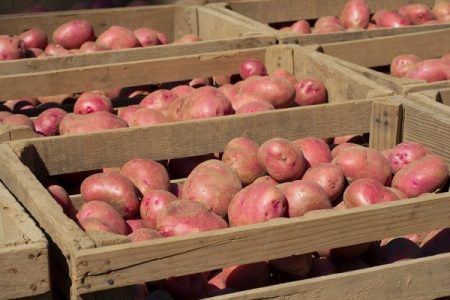
There are two ways to properly store potatoes:
- Harvest can be left on the field. But this method is only suitable for sandy soils, under which the dug potatoes themselves are almost dry and clean, and there remains the need only for their light weathering in the open. When choosing this storage method, it is worth considering the possibility of changing the weather, providing protection to the tubers from rain or the scorching sun.
- Most gardeners still prefer to use the second option of drying and storing potatoes, placing the crop in the shed structures, folding the potatoes under a canopy or in the garage.
The standard time frame when dirt remains in time from the tubers and the peel becomes dry is an interval of just one or two days. Further, the potatoes are carefully sorted according to the size of the tubers. Typically, large and medium-sized potatoes are used in cooking, while small potatoes are sent to feed stocks for livestock.
It is important when storing potatoes to observe a certain temperature, by placing a well-dried crop in a cloth bag, thus avoiding rotting. Young potatoes should not be stored for too long, but should immediately be eaten.
The experience of gardeners. Reviews and recommendations for planting and digging young potatoes
In order for the harvest of young potatoes to turn out rich and high-quality, experienced gardeners leave the following recommendations:
“I make sure to create furrows for future beds in the autumn period, that by the beginning of spring the soil was already prepared for planting young potatoes. So, the earth will warm up faster, and all the microorganisms contained in it will begin to work earlier. ”
“In addition to fertilizers and mineral fertilizing, when planting potatoes, I also bring ash into the ground, which is a source of calcium, phosphorus and useful trace elements for the soil.”
“To preserve the quality of the future crop, a solution of potassium permanganate with soapy water in the ratio of 0.1 grams helps me eliminate pests. for 10 liters. "
“The specific time when it is time to go digging potatoes, I choose according to the weather - a sunny and clear day creates excellent conditions. Digging potatoes with minimal damage to tubers is less likely to occur at high air temperatures. ”
Timely top dressing and a well-established regime for potato irrigation will allow each gardener to enjoy a high-quality and tasty harvest in the early summer season. Gradual digging of the root crop will provide potato stocks for a long time, which will please not only the owner of the collection, but also his relatives.




 Description and description of varieties in Belarus with a photo
Description and description of varieties in Belarus with a photo Do I need to pick flowers from potatoes: why do they do it
Do I need to pick flowers from potatoes: why do they do it When to dig potatoes: timing and availability of new potatoes
When to dig potatoes: timing and availability of new potatoes How to grow a good potato crop: various methods and methods, planting and care
How to grow a good potato crop: various methods and methods, planting and care